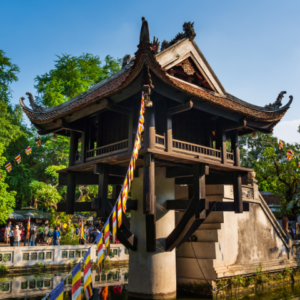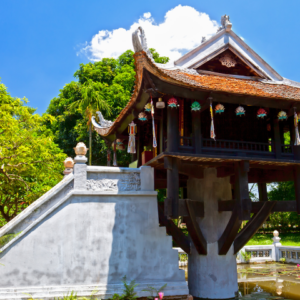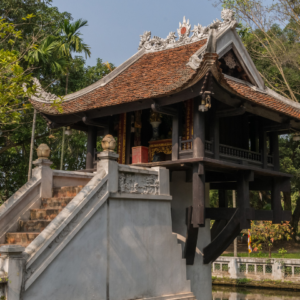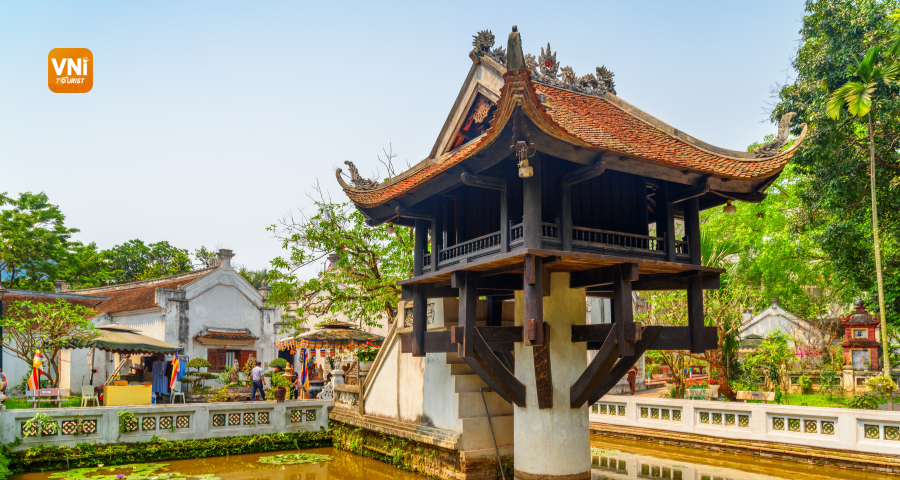One Pillar Pagoda: A Timeless Cultural and Religious Symbol of Hanoi
One Pillar Pagoda, also known as Dien Huu Pagoda, is one of the most iconic landmarks of Hanoi, embodying profound cultural, historical, and religious values. With its unique architecture and legendary story, the pagoda has become an unmissable destination for anyone visiting Vietnam’s capital.
History of One Pillar Pagoda
One Pillar Pagoda was constructed in 1049 during the reign of King Ly Thai Tong, a period when Buddhism was flourishing in Dai Viet. According to legend, King Ly Thai Tong, who was childless at the time, dreamed of the Bodhisattva Avalokiteshvara (Quan Am) seated on a lotus and handing him a baby boy. Shortly after, the queen gave birth to a prince. To express his gratitude to Avalokiteshvara, the king ordered the construction of the One Pillar Pagoda, with its design symbolizing a lotus blooming in the middle of a pond.

Over the centuries, the pagoda has witnessed many historical upheavals, including wars and changes in governance. In 1954, during the war against the French, the pagoda was destroyed and later rebuilt by the Vietnamese government based on its original design. This reconstruction was not only an effort to preserve a valuable cultural heritage but also a tribute to the nation’s spirit and respect for its history.
Unique Architecture of One Pillar Pagoda
One Pillar Pagoda stands out with its singular architecture, unmatched by any other structure. The pagoda is built on a single stone pillar about 4 meters high, intricately carved to support the entire pagoda. This architecture mimics a lotus blossom, a symbol of purity and nobility in Buddhism, blooming in the middle of a pond.
The lotus is represented in the pagoda’s roof design, with layers of tiles stacked upon each other, reflecting traditional Vietnamese architectural style. Inside the pagoda is a statue of Avalokiteshvara sitting on a lotus, exuding compassion and salvation, where many Buddhists and visitors come to pray for health, happiness, and peace.
Surrounding the pagoda is a small but serene garden, with ancient trees providing shade and a pond encircling the area, creating a tranquil and sacred atmosphere – ideal for those seeking peace and quiet amidst the bustling city.

Cultural and Religious Significance
One Pillar Pagoda is not just an architectural marvel but also a significant cultural and religious symbol of Hanoi and Vietnam. As a shrine dedicated to Avalokiteshvara, the pagoda attracts thousands of Buddhists from all over the country, especially during major Buddhist festivals such as Vu Lan or Vesak.
The religious significance of One Pillar Pagoda lies in the people’s belief in the compassion of Avalokiteshvara, a deity who listens to and rescues all beings from suffering. The pagoda has become a sanctuary where people come to pray for peace and happiness, not only for themselves but also for their families and communities.
Moreover, One Pillar Pagoda is recognized as a national cultural heritage site, with immeasurable historical and architectural value. It is an integral part of Hanoi’s cultural heritage, contributing to the preservation and promotion of the nation’s identity in the face of modernization.
Visiting and Tourism
Location and Accessibility: One Pillar Pagoda is located in the heart of Hanoi, within the grounds of the Ho Chi Minh Museum, near Ba Dinh Square. This location is highly convenient for visitors, who can easily reach it by public transportation such as buses, taxis, or motorbikes. Visitors can also combine a visit to the pagoda with other historical sites in the area, creating a meaningful cultural tour.

Visitor Information: The pagoda is open daily, from early morning until late afternoon, and there is no admission fee. However, visitors are encouraged to visit in the early morning or late afternoon to avoid crowds and fully enjoy the serene atmosphere of the pagoda. When visiting, guests should dress modestly, maintain order, and respect the sacred space.
Nearby Attractions
- Ho Chi Minh Mausoleum: Just a few steps away from the pagoda, this is where the remains of President Ho Chi Minh, the great leader of the Vietnamese people, are preserved. The mausoleum, built in a classical, solemn style, is one of the most important historical sites in Hanoi.
- Ho Chi Minh Museum: Located right next to the Mausoleum, this museum provides a comprehensive view of Ho Chi Minh’s life and career, with many valuable artifacts, images, and documents.
- Temple of Literature (Van Mieu – Quoc Tu Giam): About 2 kilometers from the One Pillar Pagoda, the Temple of Literature is Vietnam’s first university, where many of the nation’s talents were educated. It is a symbol of traditional education and the Vietnamese spirit of learning.
- Imperial Citadel of Thang Long: A UNESCO World Heritage site, about 1.5 kilometers from the pagoda. The Imperial Citadel was the political and cultural center of many Vietnamese dynasties, with many ancient relics preserved to this day.
Visitor Experience: Many visitors who have visited the One Pillar Pagoda share deep impressions of the peaceful and tranquil atmosphere of the pagoda. They often mention the feeling of relaxation, an escape from the hustle and bustle of modern life when stepping into the pagoda’s grounds. The combination of unique architecture and sacred space creates an unforgettable experience, a place to find inner balance.
Conclusion
One Pillar Pagoda is one of Hanoi’s most iconic architectural structures, embodying invaluable cultural, religious, and historical significance. Not only is it a destination for visitors from near and far, but it is also a place where the Vietnamese people’s faith, hope, and reverence are deeply rooted. With its long history, unique architecture, and profound spiritual meaning, the One Pillar Pagoda is a treasured heritage that everyone should visit when in Hanoi.

